Telescope Reviews
Page 23
By Ed Ting
Updated 2/11/05
Click on a Telescope Below:
1) Orion XT10 Intelliscope
2) Astro Sky 10" f/5.6 Dobsonian
3) Astro Physics Stowaway, Ver.2
1) Orion XT10 Intelliscope 4/11/04
(10" f/ 4.7 Newtonian, 9X50 finder, 25 mm, 10 mm Plossls, $649 + $149 for controller)
I had good things to say about the original XT10, but in late 2003 Orion surprised
everyone by offering an upgraded version of the scope with digital setting circles
(the original XT10 is still available at a lowered price of $549.) In addition
to the electronics, the new Intelliscope version has a redesigned swoopy base,
a gray tube instead of black, new mirror cell with larger collimation screws, and
a brand new tensioning system (without the pulldown springs) for both axes. The
new scope weighs 2.5 lbs less than the old version. This may not seem like a lot,
but at then end of a cold, long observing session, you'll be grateful for every
pound saved.
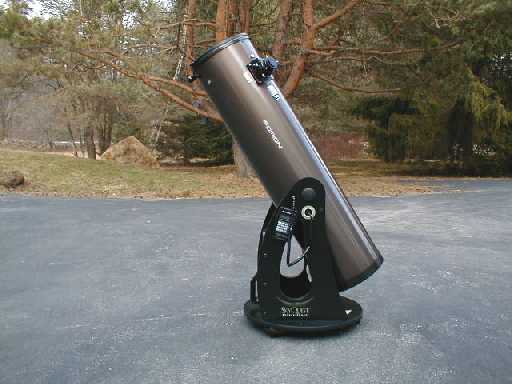 The New XT10 Intelliscope
The scope arrived in two large cartons. It was missing the manual, allen key, and
CD ROM. A quick phone call to Orion remedied this, and the omissions in any case
were not serious (the manual is available online in case this happens to you by the
way.) The instructions were well-written, with lots of cautions, explanations, and
photos. The latter was especially useful when it came time to assemble the electronics.
Even if you don't buy the controller ($149) you still get the electronic pickups for both
axes, and the encoder wheel for the azimuth bearing (the encoder wheel for the
altitude axis comes with the controller.) All in all, assembly took about 30 minutes.
The changes to the base are more than cosmetic. Both axes are completely redesigned.
The azimuth bearing rides on three teflon discs that sit in little routed-out channels
on the ground board. They are free to move in the round channels and are not attached
to anything; only the tension of the ground bolt holds them in place. You'd better keep
that ground bolt tight, because if it comes loose, you're going to lose all three teflon
pads in the grass. It's important, since those pads are the only thing protecting the
delicate azimuth circuit board from being crushed between the ground board and base
board. The altitude axis has been changed also. The side bearings rest on two slippery
round cylinders on each side, and the tension is supplied with a teflon-based knob on the
side. That's right, no more pulldown springs. You've got to be a little careful when
dropping the tube into the base, since the altitude circuit board is sitting there, exposed,
on the left hand side.
The New XT10 Intelliscope
The scope arrived in two large cartons. It was missing the manual, allen key, and
CD ROM. A quick phone call to Orion remedied this, and the omissions in any case
were not serious (the manual is available online in case this happens to you by the
way.) The instructions were well-written, with lots of cautions, explanations, and
photos. The latter was especially useful when it came time to assemble the electronics.
Even if you don't buy the controller ($149) you still get the electronic pickups for both
axes, and the encoder wheel for the azimuth bearing (the encoder wheel for the
altitude axis comes with the controller.) All in all, assembly took about 30 minutes.
The changes to the base are more than cosmetic. Both axes are completely redesigned.
The azimuth bearing rides on three teflon discs that sit in little routed-out channels
on the ground board. They are free to move in the round channels and are not attached
to anything; only the tension of the ground bolt holds them in place. You'd better keep
that ground bolt tight, because if it comes loose, you're going to lose all three teflon
pads in the grass. It's important, since those pads are the only thing protecting the
delicate azimuth circuit board from being crushed between the ground board and base
board. The altitude axis has been changed also. The side bearings rest on two slippery
round cylinders on each side, and the tension is supplied with a teflon-based knob on the
side. That's right, no more pulldown springs. You've got to be a little careful when
dropping the tube into the base, since the altitude circuit board is sitting there, exposed,
on the left hand side.
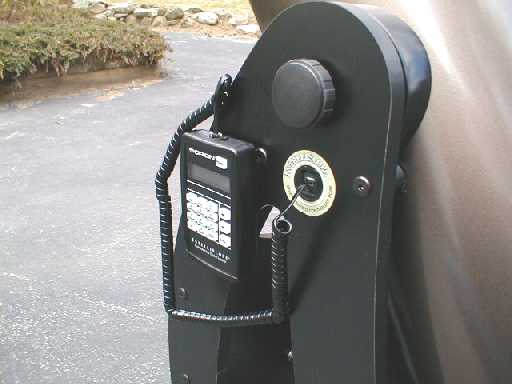 Look Ma, no springs!
The end result of all this? The scope moves really well, as least as well as before, and
now you've got adjustable tension on the altitude axis. After a few minutes of observing,
I got used to the mechanics and nothing about the scope's design really jumped out at me
(a good sign.) The swoopy holes cut into the base board not only save precious weight,
they're handy as carrying handles. I was uncomfortable carrying the original XT10 in
one piece by myself, but the cutouts on the new version make it easy for one person to
transport the unit.
The optics on this unit are very good, with only slight undercorrection. Cassini's Division
on Saturn and shadow transits on Jupiter are tack sharp in good conditions. The scope
arrived in time to hunt down galaxies in the Virgo Cluster, and the scope's nice 10" aperture
came inhandy when finding dimmer objects like the Siamese Twins (NGC 4567/4568) or the
fainter members of Markarian's Chain. NGC 891 showed good extension from my magnitude
5.0 skies.
The really big news, however, is the Intelliscope controller, available separately for $149.
There's some minor assembly you have to do, which takes another 15 minutes or so if you take
your time. If you've initialized an Autostar, NexStar, Sky Tour, Sky Wizard, Sky Commander,
etc, before you'll have no trouble with this unit. Upon power up, the controller asks you to
level the scope, then you align two stars, pressing "Enter" after each one. A couple of
seconds later, the controller gives you the amusingly-named "Warp Factor" which tells you
how good a job you did. A Warp Factor of .5 or less is said to be adequate for general use.
Some typical Warp Factors from my first session: .5, .5, 1.1, .4, .5. If these things catch
on, I can imagine Intelliscope owners bragging back and forth about their Warp Factors in
the observing field, to the befuddlement of other observers. By the way, if you're feeling
mischievous, like I was, you can try seeing how high you can get the Warp Factor by
purposely doing a bad alignment. I got it up to 30.3 once.
With a Warp Factor of .5 or less (OK, now I'm doing it) the electronics are very accurate.
I intentionally swung the scope from one side of the sky to the other in an attempt to confuse
the electronics, but the accuracy remained. The scope refused to find Venus, however. It would
find objects near Venus, but when asked to find the planet, it would consistently take me to a
place about 10 degrees away. There are few other quirks. Attempt to look at the Ghost of
Jupiter planetary and the display reads "Eye Nebula." Dial in M81 and the computer will read
"Bode's Nebula," a nomenclature I haven't seen used in decades.
The most controversial aspect of the controller, however, is its self-described energy-
saving feature. If you don't touch any buttons for 15 minutes, it shuts itself off. If you
want to observe again, you have to power up the unit and go through the alignment procedure
all over again. Most active users will be hitting buttons within the 15 minute time period,
but I don't like the idea of a meter running in the background while I'm observing (especially
if I've got a good Warp Factor dialed in.) Also, if you take a break during a long session, you
may come back to a blank screen. Perhaps this could be addressed in an upcoming firmware
upgrade. The controller also has a host of other useful options and features, and I still
hadn't gotten to use them all before the review period was up.
Based on the amazing (and often beautiful) XT-based rigs you've shown me, it's apparent that
some of you view the XT series the way a skilled painter looks at a blank canvas. It's not
a telescope, it's a means of self-expression. The Intelliscope will probably continue to
be a modkateer favorite, but use caution around the electronics. Some have reported that
a mod as simple as adding formica to the base board may disable the encoder. Why? The
thickness of the laminate moves the sensor too far away from the encoder wheel. This will
require you to sand or file the teflon pads down to compensate. The moral: be careful, and
think before you act.
The XT series continues to be my favorite entry-level telescope line. They're well-made,
robust, have good optics and mechanics, and they're cheap. Since the non electronic
versions are back in the lineup, you have a choice. I like the new computer, but after
a few nights with it I went back to using the scope the old fashioned way (by hand.)
If you share my biases, the choice may come down to whether or not the mechanical
upgrades on the Intelliscope are worth the extra $100 or not. Your choice.
2) Astro Sky 10" f/5.6 Dobsonian 2/11/05
(10" f/5.6 Newtonian, $1295 + $125 shipping)
They say everything you do in life is a reaction to something else that's happened to you.
In my case, that's certainly true. After spending 2 1/2 happy years with my 16" Night Sky
Dobsonian, I had to face the reality that I had not used it for nearly six months. I knew
the time had come to pass stewardship of it to someone else. A nice man flew up from
Philadelphia, rented a big car, and drove it home. He was happy to get the scope, I was
happy to get the money, and the scope is probably happy it's getting used, and if that's
not the definition of a good deal, I don't know what is.
I've had good luck with small manufacturers, and noticed James Grigar's Astro Sky Dobs
advertised on Astromart, and decided to give it a try. Coincidentally, like Night Sky,
Astro Sky is owned and run by a guy named Jim, who also happens to live in Louisiana.
Grigar has a simple web site that isn't fancy; it just looks like marked-up text with
photos added. Not that I am against simple web sites that are nothing more than marked-
up text with photos added. Looks who's talking.
James Grigar, who tells me he has been hearing impaired since birth, got his first scope
from K-Mart, a 15 X 30 mm hand held unit. He built an Edmund reflector shortly after.
He's been operating his web site since 1999, making mount accessories. Since June of
2004 he's been making his own Dobsonians. He plans to offer digital setting circles and
a Sky Commander on future models. This is a full-time job for him. I placed an order
for a 10" unit.
Look Ma, no springs!
The end result of all this? The scope moves really well, as least as well as before, and
now you've got adjustable tension on the altitude axis. After a few minutes of observing,
I got used to the mechanics and nothing about the scope's design really jumped out at me
(a good sign.) The swoopy holes cut into the base board not only save precious weight,
they're handy as carrying handles. I was uncomfortable carrying the original XT10 in
one piece by myself, but the cutouts on the new version make it easy for one person to
transport the unit.
The optics on this unit are very good, with only slight undercorrection. Cassini's Division
on Saturn and shadow transits on Jupiter are tack sharp in good conditions. The scope
arrived in time to hunt down galaxies in the Virgo Cluster, and the scope's nice 10" aperture
came inhandy when finding dimmer objects like the Siamese Twins (NGC 4567/4568) or the
fainter members of Markarian's Chain. NGC 891 showed good extension from my magnitude
5.0 skies.
The really big news, however, is the Intelliscope controller, available separately for $149.
There's some minor assembly you have to do, which takes another 15 minutes or so if you take
your time. If you've initialized an Autostar, NexStar, Sky Tour, Sky Wizard, Sky Commander,
etc, before you'll have no trouble with this unit. Upon power up, the controller asks you to
level the scope, then you align two stars, pressing "Enter" after each one. A couple of
seconds later, the controller gives you the amusingly-named "Warp Factor" which tells you
how good a job you did. A Warp Factor of .5 or less is said to be adequate for general use.
Some typical Warp Factors from my first session: .5, .5, 1.1, .4, .5. If these things catch
on, I can imagine Intelliscope owners bragging back and forth about their Warp Factors in
the observing field, to the befuddlement of other observers. By the way, if you're feeling
mischievous, like I was, you can try seeing how high you can get the Warp Factor by
purposely doing a bad alignment. I got it up to 30.3 once.
With a Warp Factor of .5 or less (OK, now I'm doing it) the electronics are very accurate.
I intentionally swung the scope from one side of the sky to the other in an attempt to confuse
the electronics, but the accuracy remained. The scope refused to find Venus, however. It would
find objects near Venus, but when asked to find the planet, it would consistently take me to a
place about 10 degrees away. There are few other quirks. Attempt to look at the Ghost of
Jupiter planetary and the display reads "Eye Nebula." Dial in M81 and the computer will read
"Bode's Nebula," a nomenclature I haven't seen used in decades.
The most controversial aspect of the controller, however, is its self-described energy-
saving feature. If you don't touch any buttons for 15 minutes, it shuts itself off. If you
want to observe again, you have to power up the unit and go through the alignment procedure
all over again. Most active users will be hitting buttons within the 15 minute time period,
but I don't like the idea of a meter running in the background while I'm observing (especially
if I've got a good Warp Factor dialed in.) Also, if you take a break during a long session, you
may come back to a blank screen. Perhaps this could be addressed in an upcoming firmware
upgrade. The controller also has a host of other useful options and features, and I still
hadn't gotten to use them all before the review period was up.
Based on the amazing (and often beautiful) XT-based rigs you've shown me, it's apparent that
some of you view the XT series the way a skilled painter looks at a blank canvas. It's not
a telescope, it's a means of self-expression. The Intelliscope will probably continue to
be a modkateer favorite, but use caution around the electronics. Some have reported that
a mod as simple as adding formica to the base board may disable the encoder. Why? The
thickness of the laminate moves the sensor too far away from the encoder wheel. This will
require you to sand or file the teflon pads down to compensate. The moral: be careful, and
think before you act.
The XT series continues to be my favorite entry-level telescope line. They're well-made,
robust, have good optics and mechanics, and they're cheap. Since the non electronic
versions are back in the lineup, you have a choice. I like the new computer, but after
a few nights with it I went back to using the scope the old fashioned way (by hand.)
If you share my biases, the choice may come down to whether or not the mechanical
upgrades on the Intelliscope are worth the extra $100 or not. Your choice.
2) Astro Sky 10" f/5.6 Dobsonian 2/11/05
(10" f/5.6 Newtonian, $1295 + $125 shipping)
They say everything you do in life is a reaction to something else that's happened to you.
In my case, that's certainly true. After spending 2 1/2 happy years with my 16" Night Sky
Dobsonian, I had to face the reality that I had not used it for nearly six months. I knew
the time had come to pass stewardship of it to someone else. A nice man flew up from
Philadelphia, rented a big car, and drove it home. He was happy to get the scope, I was
happy to get the money, and the scope is probably happy it's getting used, and if that's
not the definition of a good deal, I don't know what is.
I've had good luck with small manufacturers, and noticed James Grigar's Astro Sky Dobs
advertised on Astromart, and decided to give it a try. Coincidentally, like Night Sky,
Astro Sky is owned and run by a guy named Jim, who also happens to live in Louisiana.
Grigar has a simple web site that isn't fancy; it just looks like marked-up text with
photos added. Not that I am against simple web sites that are nothing more than marked-
up text with photos added. Looks who's talking.
James Grigar, who tells me he has been hearing impaired since birth, got his first scope
from K-Mart, a 15 X 30 mm hand held unit. He built an Edmund reflector shortly after.
He's been operating his web site since 1999, making mount accessories. Since June of
2004 he's been making his own Dobsonians. He plans to offer digital setting circles and
a Sky Commander on future models. This is a full-time job for him. I placed an order
for a 10" unit.
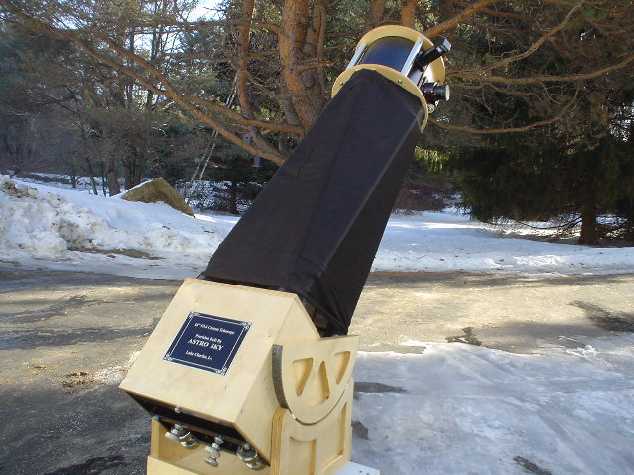 The 10" f/5.6 Astro Sky Dob
Delivery of the scope took about 2 months, which is pretty fast for a custom Dob. It came
very well packed, and like other nice scopes I've bought, it took as long to unpack the
parts as it did to assemble it. If you're used to putting together a truss Dob, there aren't
any big surprises. There are four truss pole units, hinged in the middle to form eight
trusses. The hinge at the top is clamped to the upper truss assembly with a locking cam,
like the quick-release lever on the wheel of your bicycle. The scope has a reasonable
eyepiece height (no ladder necessary) and weighs about 61 lbs. The bearings are standard
teflon on formica, and I would rate its "sticktion" as middle-of-the-road - not too loose,
not too binding. The finish is, well, beautiful. I am getting so used to seeing beautiful
woodworking on telescopes these days that it's easy to get jaded. Suffice it to say that
the level of woodworking here is far beyond anything that I could accomplish. There's a
really nice metal nameplate on the rocker box.
The scope uses a sling, a bit unusual for a mirror this small. If you're not familiar with
how a sling works, picture a mirror sitting on its edge on a hammock. Now tilt the mirror
back gently so that it rests on three (or more) triangular metal plates lined with felt.
That's a sling. This sounds precarious, but in actual use a sling can be quite sturdy,
and can hold its collimation very well. After driving the scope around in my aging, rattling
1995 Grand Cherokee, I found the mirror needed only minor adjustments when I got to the
observing site. The major difficulty with a sling is its initial adjustment. Hint: the bottom
of the mirror should rest on the sling, and only the sling. If it's resting on one of the
posts, you haven't got it right.
The 10" f/5.6 Astro Sky Dob
Delivery of the scope took about 2 months, which is pretty fast for a custom Dob. It came
very well packed, and like other nice scopes I've bought, it took as long to unpack the
parts as it did to assemble it. If you're used to putting together a truss Dob, there aren't
any big surprises. There are four truss pole units, hinged in the middle to form eight
trusses. The hinge at the top is clamped to the upper truss assembly with a locking cam,
like the quick-release lever on the wheel of your bicycle. The scope has a reasonable
eyepiece height (no ladder necessary) and weighs about 61 lbs. The bearings are standard
teflon on formica, and I would rate its "sticktion" as middle-of-the-road - not too loose,
not too binding. The finish is, well, beautiful. I am getting so used to seeing beautiful
woodworking on telescopes these days that it's easy to get jaded. Suffice it to say that
the level of woodworking here is far beyond anything that I could accomplish. There's a
really nice metal nameplate on the rocker box.
The scope uses a sling, a bit unusual for a mirror this small. If you're not familiar with
how a sling works, picture a mirror sitting on its edge on a hammock. Now tilt the mirror
back gently so that it rests on three (or more) triangular metal plates lined with felt.
That's a sling. This sounds precarious, but in actual use a sling can be quite sturdy,
and can hold its collimation very well. After driving the scope around in my aging, rattling
1995 Grand Cherokee, I found the mirror needed only minor adjustments when I got to the
observing site. The major difficulty with a sling is its initial adjustment. Hint: the bottom
of the mirror should rest on the sling, and only the sling. If it's resting on one of the
posts, you haven't got it right.
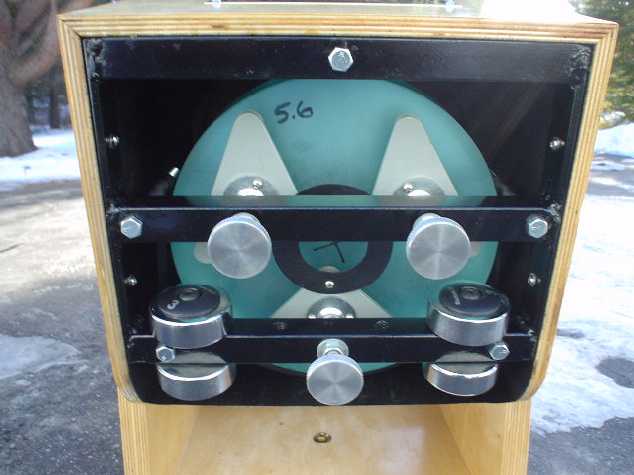 Close up of the mirror tailgate and sling
I've seen more than my share of front-heavy Dobs lately, and this was one of them. Putting
in anything heavier than a 19 mm Panoptic would cause the front end to slowly droop to the
ground. When I reported this to Grigar, he generously offered to make me an entire new,
heavier tailgate assembly. The new tailgate arrived about two weeks later, and I spent
a couple of hours switching it out for the old one. The scope is balanced perfectly now.
Mine was the first sample of this size off the line, so little issues like this should be
resolved by the time you read this. James says he is also working on a set of detailed
instructions, complete with photos.
The scope uses a Discovery mirror. It's a good one. The optics are only slightly under-
corrected, nothing to worry about. I spent some nice evenings looking at the winter sky
objects. Under steady conditions, all six members of the Trapezium are easy. The Blinking
Planetary is just getting bright enough in a 10" that it will sometimes refuse to "blink."
Saturn shows at least six moons if you know where to look. Winter is an especially good
time to go hunting for open clusters, and I spent a lot of time picking out open clusters
in Canis Major and Minor, Cassiopeia, Monoceros, and Auriga.
Close up of the mirror tailgate and sling
I've seen more than my share of front-heavy Dobs lately, and this was one of them. Putting
in anything heavier than a 19 mm Panoptic would cause the front end to slowly droop to the
ground. When I reported this to Grigar, he generously offered to make me an entire new,
heavier tailgate assembly. The new tailgate arrived about two weeks later, and I spent
a couple of hours switching it out for the old one. The scope is balanced perfectly now.
Mine was the first sample of this size off the line, so little issues like this should be
resolved by the time you read this. James says he is also working on a set of detailed
instructions, complete with photos.
The scope uses a Discovery mirror. It's a good one. The optics are only slightly under-
corrected, nothing to worry about. I spent some nice evenings looking at the winter sky
objects. Under steady conditions, all six members of the Trapezium are easy. The Blinking
Planetary is just getting bright enough in a 10" that it will sometimes refuse to "blink."
Saturn shows at least six moons if you know where to look. Winter is an especially good
time to go hunting for open clusters, and I spent a lot of time picking out open clusters
in Canis Major and Minor, Cassiopeia, Monoceros, and Auriga.
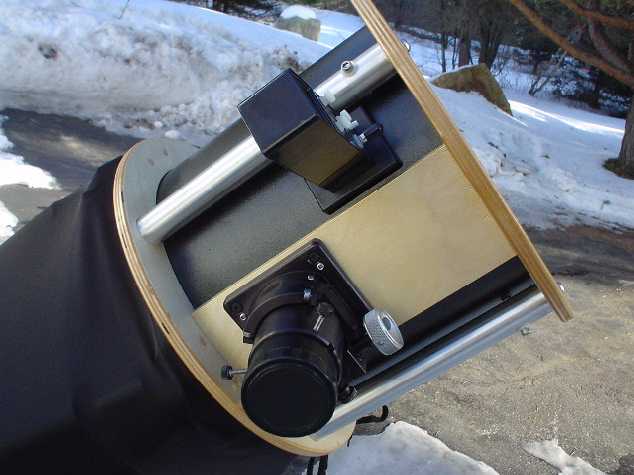 Close up of the upper truss assembly
As I've noted before, the best reviews tend to be the short ones. Once the balance issue
(above) was addressed, I didn't really think about the scope much while I was observing.
It just gets out of the way. I'm glad I bought it, and I can already tell it's going to
get a lot of use.
Should you get one? If you're the type of observer that needs one of the "status" brands,
this Astro Sky might not stroke your ego enough. If you're a fan of big scopes and LIKE
YOUR IMAGES REALLY BRIGHT, 10" might not be big enough for you (Astro Sky does
offer larger models though.) But if you're in the market for a medium aperture Dobsonian,
the Astro Sky is well-made, has good optics, its delivery time is reasonable, and the price
is right. What's not to like?
Astro-Physics Stowaway, Version 2 (Brief review, with photos) 2/11/05
(92 mm f/7 apochromatic refractor, NLA)
I thought you'd appreciate seeing the 2nd version of the Astro-Physics Stowaway. Released
in very limited quantities in 2002, this newer Stowaway was a longer f/7 (as opposed to the
earlier f/5 version) and is like a mini-Traveler in white. It comes in the Traveler's case.
The scope is longer and thinner than the older Stowaway. There is no provision for a finder,
but you shouldn't need one on a scope with a focal length this short. There's a beautiful
two-speed focuser. The dew shield extends, but not as far as you might think, looking at it.
Close up of the upper truss assembly
As I've noted before, the best reviews tend to be the short ones. Once the balance issue
(above) was addressed, I didn't really think about the scope much while I was observing.
It just gets out of the way. I'm glad I bought it, and I can already tell it's going to
get a lot of use.
Should you get one? If you're the type of observer that needs one of the "status" brands,
this Astro Sky might not stroke your ego enough. If you're a fan of big scopes and LIKE
YOUR IMAGES REALLY BRIGHT, 10" might not be big enough for you (Astro Sky does
offer larger models though.) But if you're in the market for a medium aperture Dobsonian,
the Astro Sky is well-made, has good optics, its delivery time is reasonable, and the price
is right. What's not to like?
Astro-Physics Stowaway, Version 2 (Brief review, with photos) 2/11/05
(92 mm f/7 apochromatic refractor, NLA)
I thought you'd appreciate seeing the 2nd version of the Astro-Physics Stowaway. Released
in very limited quantities in 2002, this newer Stowaway was a longer f/7 (as opposed to the
earlier f/5 version) and is like a mini-Traveler in white. It comes in the Traveler's case.
The scope is longer and thinner than the older Stowaway. There is no provision for a finder,
but you shouldn't need one on a scope with a focal length this short. There's a beautiful
two-speed focuser. The dew shield extends, but not as far as you might think, looking at it.
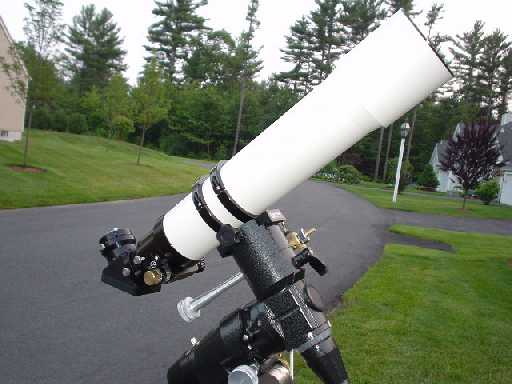 The new AP Stowaway, on a CG5 mount
Exact figures on production numbers are hard to come by, but most people seem to feel that
somewhere between 50 and 75 of these are lurking out there. Not that they are easy to find.
The owner of this one does not take the scope off his property, and most of the time it is
safely "stowed away" at an undisclosed location in the house. It was all I could do just
to get to see it at all.
The new AP Stowaway, on a CG5 mount
Exact figures on production numbers are hard to come by, but most people seem to feel that
somewhere between 50 and 75 of these are lurking out there. Not that they are easy to find.
The owner of this one does not take the scope off his property, and most of the time it is
safely "stowed away" at an undisclosed location in the house. It was all I could do just
to get to see it at all.
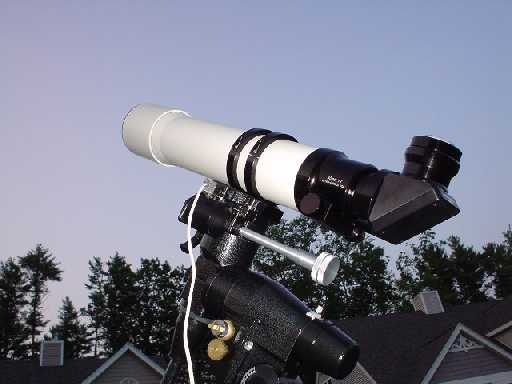 Another view
Astro-Physics refractor owners are, of course, passionate people. I do not know of any group,
save perhaps Questar owners, who are so loyal to their beloved scopes. Some owners wax their
AP scopes more often than they wax their cars, and many go to sleep with their refractors
underneath their beds at night.
Another view
Astro-Physics refractor owners are, of course, passionate people. I do not know of any group,
save perhaps Questar owners, who are so loyal to their beloved scopes. Some owners wax their
AP scopes more often than they wax their cars, and many go to sleep with their refractors
underneath their beds at night.
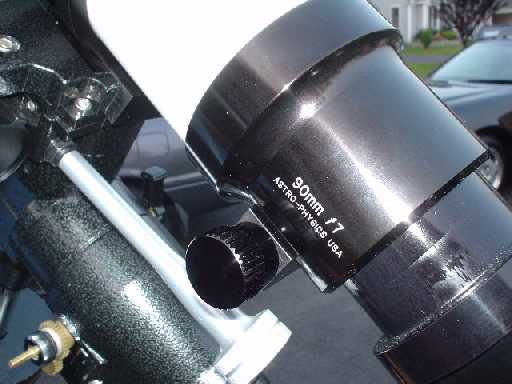 Close up of the focuser
As I only spent a little time with the Stowaway, there's not much I can report in the way of
observations. The star test was about as perfect as I have found in a refractor. I couldn't
see any false color. The owner, who is an experienced observer, says it is about as perfect
as a small refractor can be.
As of this writing, AP is completely revamping their telescope line. The 92, 105, 130, and
155 apertures have apparently been retired, and new models will appear soon. I do know that
some people on the 155 waiting list were contacted to see if they wished to purchase one of
the new AP160 units ($7950.)
Close up of the focuser
As I only spent a little time with the Stowaway, there's not much I can report in the way of
observations. The star test was about as perfect as I have found in a refractor. I couldn't
see any false color. The owner, who is an experienced observer, says it is about as perfect
as a small refractor can be.
As of this writing, AP is completely revamping their telescope line. The 92, 105, 130, and
155 apertures have apparently been retired, and new models will appear soon. I do know that
some people on the 155 waiting list were contacted to see if they wished to purchase one of
the new AP160 units ($7950.)
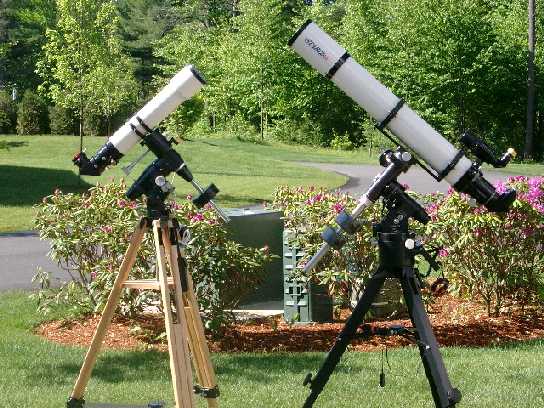 Stowaway (L) next to an older AP Star 12 (R)
Mounts: CG5 (Stowaway), Losmandy GM-8 (Star 12)
If you're looking for a high-performance compact refractor, you can purchase a nice
apochromat from TeleVue, Takahashi, TMB, or the others, and you'll be perfectly happy.
On the other hand, if you're a telescope collector and simply have to have one of these,
sell off that mutual fund and hit the astronomy classifieds; I wish you luck, and good
hunting.
Stowaway (L) next to an older AP Star 12 (R)
Mounts: CG5 (Stowaway), Losmandy GM-8 (Star 12)
If you're looking for a high-performance compact refractor, you can purchase a nice
apochromat from TeleVue, Takahashi, TMB, or the others, and you'll be perfectly happy.
On the other hand, if you're a telescope collector and simply have to have one of these,
sell off that mutual fund and hit the astronomy classifieds; I wish you luck, and good
hunting.
OK, folks, that's it for a while. I'm going to give this reviewing thing a rest. It's
been years since I've gone observing just for the pleasure of it, and it's high time
I get back to it. Scopereviews is now on official hiatus! You'll see some articles
by me from time to time in the astronomy magazines, but by and large I'm going
to take it easy. Enjoy these archived reviews, and I'll see you under the stars!
-Ed 2/11/05
End Telescope Reviews, Page 23
Back to Home Page